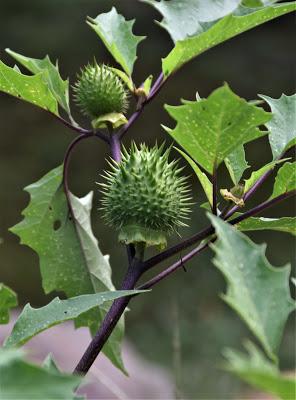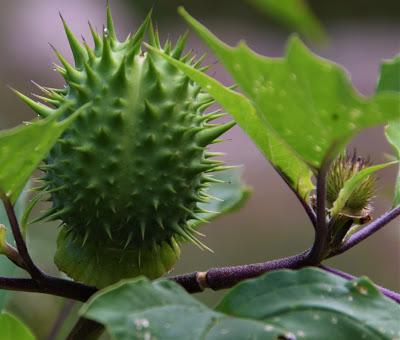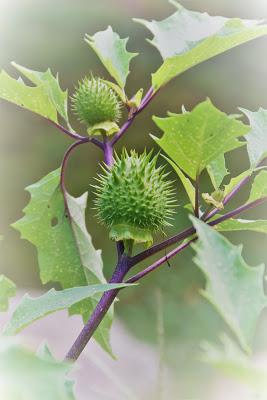 These dramatic seed pods carry a warning -- poison! Jimsonweed (Datura stramonium) is common around here -- this one showed up in our garden. I already knew it has hallucinogenic qualities--a neighbor told me years ago that when she was young, thrill-seeking teenagers would lay one of the little seeds inside their lower eyelid and it would make then see strange things.
What I didn't know was that the name Jimsonweed was originally Jamestown Weed, derived from Jamestown, Virginia where English soldiers, attempting to put down a rebellion in 1676, boiled and ate a quantity of the leaves "the effect of which was a very pleasant comedy, for they turned natural fools upon it for several days: one would blow a feather up in the air; another would dart straws at it with much fury; and another, stark naked, was sitting in a corner like a monkey . . .
These dramatic seed pods carry a warning -- poison! Jimsonweed (Datura stramonium) is common around here -- this one showed up in our garden. I already knew it has hallucinogenic qualities--a neighbor told me years ago that when she was young, thrill-seeking teenagers would lay one of the little seeds inside their lower eyelid and it would make then see strange things.
What I didn't know was that the name Jimsonweed was originally Jamestown Weed, derived from Jamestown, Virginia where English soldiers, attempting to put down a rebellion in 1676, boiled and ate a quantity of the leaves "the effect of which was a very pleasant comedy, for they turned natural fools upon it for several days: one would blow a feather up in the air; another would dart straws at it with much fury; and another, stark naked, was sitting in a corner like a monkey . . .
In this frantic condition they were confined, lest they should, in their folly, destroy themselves--though it was observed that all their actions were full of innocence and good nature. . .a thousand such simple tricks they played, and after eleven days returned to themselves again, not remembering anything that had passed."
(From The History and Present State of Virginia, Book II-1705

I'm not tempted. Depending on where you live, the plant is also called thornapple, moon flower, hell's bells, devil's trumpet, devil's weed, stinkweed, locoweed, prickly burr, or devil's cucumber. Its poisonous ingredients include atropine, scopolomine, hyoscyamine, and tryopane alkaloids. A perfect plant for a witch's garden. Maybe between to the foxglove and deadly nightshade . . .

